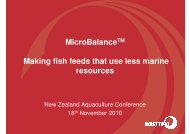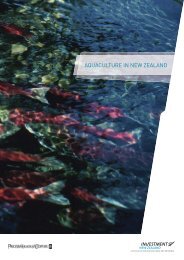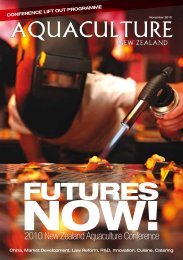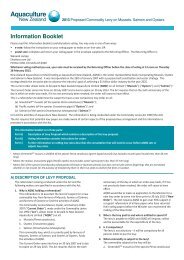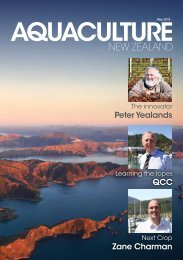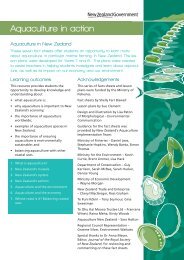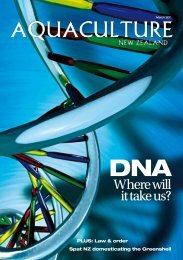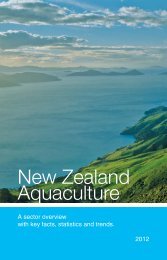The use of Marine Resources in New Zealand Salmon Farming (PDF)
The use of Marine Resources in New Zealand Salmon Farming (PDF)
The use of Marine Resources in New Zealand Salmon Farming (PDF)
Create successful ePaper yourself
Turn your PDF publications into a flip-book with our unique Google optimized e-Paper software.
<strong>The</strong> <strong>use</strong> <strong>of</strong> <strong>Mar<strong>in</strong>e</strong> <strong>Resources</strong> <strong>in</strong> <strong>New</strong> <strong>Zealand</strong><strong>Salmon</strong> Farm<strong>in</strong>gBackgroundFarmed salmon <strong>in</strong> <strong>New</strong> <strong>Zealand</strong> are fed manufactured diets that conta<strong>in</strong>fishmeal and fish oil. This document summarises some key facts on the <strong>use</strong> <strong>of</strong>these materials.Global fishmeal and fish oil supplyFishmeal can be divided <strong>in</strong>to two classes – trimm<strong>in</strong>g meals (by-products <strong>of</strong>fish caught for human consumption, e.g. the frame) and reduction meals (fromfish caught and processed whole for the purpose <strong>of</strong> mak<strong>in</strong>g fishmeal and oil).Fish oil is produced dur<strong>in</strong>g the fishmeal manufactur<strong>in</strong>g process. <strong>The</strong> majority(>80%) <strong>of</strong> fishmeal <strong>use</strong>d <strong>in</strong> the NZ salmon <strong>in</strong>dustry comes from reductionfisheries, primarily the Peruvian anchovy fishery.Anchovy and other reduction fisheries are <strong>of</strong>ten resilient to fish<strong>in</strong>g pressurebeca<strong>use</strong> they <strong>in</strong>volve fast-grow<strong>in</strong>g and short-lived species. <strong>The</strong> Peruviananchovy fishery is generally regarded as well managed and susta<strong>in</strong>able (e.g.http://www.fishsource.org/), but like all fishmeal sources, is fully exploited.<strong>The</strong>re is no possibility <strong>of</strong> more fishmeal and fish oil be<strong>in</strong>g produced <strong>in</strong> theworld than is currently be<strong>in</strong>g produced.As a result <strong>of</strong> lack <strong>of</strong> supply and <strong>in</strong>creas<strong>in</strong>g demand, prices <strong>of</strong> fishmeal andfish oil cont<strong>in</strong>ue to rise and there has been huge <strong>in</strong>vestment by the<strong>in</strong>ternational aquaculture <strong>in</strong>dustry towards discover<strong>in</strong>g how to make fish dietsthat <strong>use</strong> less fishmeal and fish oil, while still produc<strong>in</strong>g healthy fish that aregood to eat. Typical substitutes <strong>use</strong>d <strong>in</strong> the NZ salmon <strong>in</strong>dustry are plantprote<strong>in</strong>s and oils and by-products from the poultry and meat <strong>in</strong>dustries, fromanimals raised for human consumption.Fishmeal and Fish Oil <strong>use</strong> <strong>in</strong> NZ <strong>Salmon</strong> Farm<strong>in</strong>g<strong>The</strong> figures given here are based on typical average farm<strong>in</strong>g practice and realdiet formulations <strong>use</strong>d <strong>in</strong> the NZ <strong>in</strong>dustry. It can be seen that a great deal <strong>of</strong>progress has been made <strong>in</strong> reduc<strong>in</strong>g reliance on mar<strong>in</strong>e resources <strong>in</strong> NZsalmon farm<strong>in</strong>g.
Figure 1. Fishmeal and fish oil <strong>in</strong>clusion <strong>in</strong> diets <strong>use</strong>d <strong>in</strong> NZ <strong>Salmon</strong> farm<strong>in</strong>g,<strong>in</strong>clud<strong>in</strong>g meals from trimm<strong>in</strong>g meals. Research on fishmeal and fish oil replacementhas allowed the <strong>use</strong> <strong>of</strong> mar<strong>in</strong>e <strong>in</strong>gredients to be greatly reduced, while stillma<strong>in</strong>ta<strong>in</strong><strong>in</strong>g fish health and quality.
Figure 2. Tonnes <strong>of</strong> wild fish required to produce one tonne <strong>of</strong> farmed NZ <strong>Salmon</strong>(excludes trimm<strong>in</strong>g meals which were not caught for the purpose <strong>of</strong> produc<strong>in</strong>gfishmeal). Note that the fish <strong>use</strong>d for fishmeal and fish oil overlap – the same wild fishyield both fishmeal and fish oil, separate fish are not caught for each. For comparisonthe wild fish needed to produce one tonne <strong>of</strong> wild salmon is shown (thought to bebetween 10 and 20 tonnes consumed per tonne <strong>of</strong> wild salmon produced).
Figure 3. NZ <strong>Salmon</strong> farm<strong>in</strong>g currently produces more fish prote<strong>in</strong> than it consumes.For every tonne <strong>of</strong> fish prote<strong>in</strong> consumed, 1.19 tonnes is produced.Figure 4. NZ <strong>Salmon</strong> farm<strong>in</strong>g currently produces more fish oil than it consumes. Forevery tonne <strong>of</strong> fish oil consumed, 1.22 tonnes is produced.



